Photophysical Properties of Protoporphyrin IX, Pyropheophorbide-a, and Photofrin® in Different Conditions
Abstract
1. Introduction
2. Results and Discussion
2.1. Influence of the Solvent
2.2. Influence of the Medium Viscosity
2.3. Influence of the Concentration
2.4. Influence of the Temperature
2.5. Influence of pH Medium
3. Materials and Methods
3.1. Spectroscopic Measurements
3.2. Fluorescence and Luminescence Decays
4. Conclusions
Supplementary Materials
Author Contributions
Funding
Institutional Review Board Statement
Informed Consent Statement
Data Availability Statement
Acknowledgments
Conflicts of Interest
References
- Price, M.; Heilbrun, L.; Kessel, D. Effects of the oxygenation level on formation of different reactive oxygen species during photodynamic therapy. Photochem. Photobiol. 2013, 89, 683–686. [Google Scholar] [CrossRef]
- Castano, A.P.; Mroz, P.; Hamblin, M.R. Photodynamic therapy and anti-tumor immunity. Nat. Rev. Cancer 2006, 6, 535–545. [Google Scholar] [CrossRef] [PubMed]
- Sansaloni-Pastor, S.; Bouilloux, J.; Lange, N. The Dark Side: Photosensitizer Prodrugs. Pharmaceuticals 2019, 12, 148. [Google Scholar] [CrossRef] [PubMed]
- Abrahamse, H.; Hamblin, M.R. New Photosensitizers for Photodynamic Therapy. Biochem. J. 2016, 473, 347–364. [Google Scholar] [CrossRef]
- Stamati, I.; Kuimova, M.K.; Lion, M.; Yahioglu, G.; Phillips, D.; Deonarain, M.P. Novel Photosensitisers Derived from Pyropheophorbide-a: Uptake by Cells and Photodynamic Efficiency in Vitro. Photochem. Photobiol. Sci. 2010, 9, 1033–1041. [Google Scholar] [CrossRef]
- Bonneau, C.; Vever-Bizet, C. Tetrapyrrole photosensitisers, determinants of subcellular localisation and mechanisms of photodynamic processes in therapeutic approaches. Exp. Opin. Therap. Pat. 2008, 18, 1011–1025. [Google Scholar] [CrossRef]
- Mojzisova, H.; Bonneau, S.; Brault, D. Structural and physico-chemical determinants of the interactions of macrocyclic photosensitizers with cells. Eur. Biophys. J. 2007, 36, 943–953. [Google Scholar] [CrossRef]
- Kelbauskas, L.; Dietel, W. Internalization of Aggregated Photosensitizers by Tumor Cells: Subcellular Time-resolved Fluorescence Spectroscopy on Derivatives of Pyropheophorbide-a Ethers and Chlorin e6 under Femtosecond One- and Two-photon Excitation. Photochem. Photobiol. 2002, 76, 686–694. [Google Scholar] [CrossRef]
- Shiah, J.G.; Konák, C.; Spikes, J.D.; Kopecek, J. Influence of pH on aggregation and photoproperties of n-(2-hydroxypropyl) methacrylamide copolymer-meso-chlorin e6 conjugates. Drug Deliv. 1998, 5, 119–126. [Google Scholar] [CrossRef]
- Roeder, B.; Wabnitz, H. Time-resolved fluorescence spectroscopy of hematoporphyrin, mesoporphyrin, pheophorbide a and chlorin e6 in ethanol and aqueous solution. J. Photochem. Photobiol. B 1987, 1, 103–113. [Google Scholar] [CrossRef]
- Margalit, R.; Cohen, S. Studies of hematoporphyrin and hematoporphyrin derivative equilibria in heterogeneous systems. Porphyrin-liposome binding and porphyrin aqueous dimerization. Biochim. Biophys. Acta 1983, 736, 163–170. [Google Scholar] [CrossRef]
- Margalit, R.; Rotenberg, M. Thermodynamics of porphyrin dimerization in aqueous solutions. Biochem. J. 1984, 219, 445–450. [Google Scholar] [CrossRef] [PubMed]
- Eichwurzel, I.; Stiel, H.; Röder, B. Photophysical studies of the pheophorbide a dimer. J. Photochem. Photobiol. B 2000, 54, 194–200. [Google Scholar] [CrossRef]
- Macdonald, J.I.; Dougherty, J.T. Basic principles of photodynamic therapy. J. Porphyr. Phthalocyanines 2001, 5, 105–129. [Google Scholar] [CrossRef]
- Niedre, M.J.; Yu, C.S.; Patterson, M.; Wilson, B.C. Singlet oxygen luminescence as an in vivo photodynamic therapy dose metric: Validation in normal mouse skin with topical amino-levulinic acid. Br. J. Cancer 2005, 92, 298–304. [Google Scholar] [CrossRef] [PubMed]
- Kohoutova, D.; Haidry, R.; Banks, M.; Butt, M.A.; Dunn, J.; Thorpe, S.; Lovat, L. Long-term outcomes of the randomized controlled trial comparing 5-aminolaevulinic acid and Photofrin photodynamic therapy for Barrett’s esophagus related neoplasia. Scand. J. Gastroenterol. 2018, 53, 527–532. [Google Scholar] [CrossRef]
- Schaffer, M.; Schaffer, P.M.; Vogesser, M.; Ertl-Wagner, B.; Rauch, J.; Oberneder, R.; Jori, G.; Hofstetter, A.; Dühmke, E. Application of Photofrin II as a specific radiosensitising agent in patients with bladder cancer—A report of two cases. Photochem. Photobiol. Sci. 2002, 1, 686–689. [Google Scholar] [CrossRef]
- Schaffer, M.; Ertl-Wagner, B.; Schaffer, P.M.; Kulka, U.; Jori, G.; Dühmke, E.; Hofstetter, A. The Application of Photofrin II® as a Sensitizing Agent for Ionizing Radiation—A New Approach in Tumor Therapy. Curr. Med. Chem. 2005, 12, 1209–1215. [Google Scholar] [CrossRef]
- Schaffer, M.; Ertl-Wagner, B.; Schaffer, P.M.; Kulka, U.; Jori, G.; Wilkowski, R.; Hofstetter, A.; Dühmke, E. Feasibility of Photofrin II as a Radiosensitizing Agent in Solid Tumors—Preliminary Results. Onkologie 2006, 29, 514–519. [Google Scholar] [CrossRef]
- Kou, J.; Dou, D.; Yang, L. Porphyrin photosensitizers in photodynamic therapy and its applications. Oncotarget 2017, 8, 81591–81603. [Google Scholar] [CrossRef]
- Schaffer, P.; Batash, R.; Ertl-Wagner, B.; Hofstetter, A.; Asna, N.; Schaffer, M. Treatment of cervix carcinoma FIGO IIIb with Photofrin II as a radiosensitizer: A case report. Photochem. Photobiol. Sci. 2019, 18, 1275–1279. [Google Scholar] [CrossRef]
- Schaffer, M.; Schaffer, P.M.; Corti, L.; Gardiman, M.; Sotti, G.; Hofstetter, A.; Dühmke, E. Photofrin as a specific radiosensitizing agent for tumors: Studies in comparison to other porphyrins, in an experimental in vivo model. J. Photochem. Photobiol. B 2002, 66, 157–164. [Google Scholar] [CrossRef]
- Chang, C.J.; Cheng, S.M.; Nelson, J.S. Microvascular effects of Photofrin®-induced photodynamic therapy. Photodiagn. Photodyn. Ther. 2007, 4, 95–99. [Google Scholar] [CrossRef] [PubMed][Green Version]
- Berger, Y.; Greppi, A.; Siri, O.; Neier, R.; Juillerat-Jeanneret, L. Ethylene glycol and amino acid derivatives of 5-aminolevulinic acid as new photosensitizing precursors of protoporphyrin IX in cells. J. Med. Chem. 2000, 43, 4738–4746. [Google Scholar] [CrossRef] [PubMed]
- Collaud, S.; Juzeniene, A.; Moan, J.; Lange, N. On the selectivity of 5-aminolevulinic acid-induced protoporphyrin IX formation. Curr. Med. Chem. Anticancer Agents 2004, 4, 301–316. [Google Scholar] [CrossRef]
- Moan, J.; Bech, Ø.; Gaullier, J.M.; Stokke, T.; Steen, H.B.; Ma, L.; Berg, K. Protoporphyrin IX accumulation in cells treated with 5-aminolevulinic acid: Dependence on cell density, cell size and cell cycle. Int. J. Cancer 1998, 75, 134–139. [Google Scholar] [CrossRef]
- Choudhary, S.; Nouri, K.; Elsaie, M.L. Photodynamic therapy in dermatology: A review. Lasers Med. Sci. 2009, 24, 971–980. [Google Scholar] [CrossRef]
- Guelluy, P.H.; Marie-Pierre, F.A.; Grammenos, A.; Lecart, S.; Piette, J.; Hoebeke, M. Optimizing photodynamic therapy by liposomal formulation of the photosensitizer pyropheophorbide-a methyl ester: In vitro and ex vivo comparative biophysical investigations in a colon carcinoma cell line. Photochem. Photobiol. Sci. 2010, 9, 1252–1260. [Google Scholar] [CrossRef]
- Siwawannapong, K.; Zhang, R.; Lei, H.; Jin, Q.; Tang, W.; Dong, Z.; Lai, R.Y.; Liu, Z.; Kamkaew, A.; Cheng, L. Ultra-small Pyropheophorbide-a Nanodots for Near-infrared Fluorescence/Photoacoustic Imaging-guided Photodynamic Therapy. Theranostics 2020, 10, 62–73. [Google Scholar] [CrossRef] [PubMed]
- Scolaro, L.M.; Castriciano, M.; Romeo, A.; Patanè, S.; Cefalì, A.; Allegrini, M.G. Aggregation Behavior of Protoporphyrin IX in Aqueous Solutions: Clear Evidence of Vesicle Formation. J. Phys. Chem. B 2002, 106, 2453–2459. [Google Scholar] [CrossRef]
- Delanaye, L.; Bahri, M.; Tfibel, F.; Fontaine-Aupart, M.; Mouithys-Mickalad, A.; Heine, B.; Piette, J.; Hoebeke, M. Physical and chemical properties of pyropheophorbide-a methyl ester in ethanol, phosphate buffer and aqueous dispersion of small unilamellar dimyristoyl-L-α-phosphatidylcholine vesicles. Photochem. Photobiol. Sci. 2006, 5, 317–325. [Google Scholar] [CrossRef]
- Gomes, A.T.P.C.; Neves, M.G.P.M.S.; Cavaleiro, J.A.S. Cancer, Photodynamic Therapy and Porphyrin-Type Derivatives. An. Acad. Bras. Cienc. 2018, 90, 993–1026. [Google Scholar] [CrossRef]
- Kubát, P.; Lang, K.; Procházková, K.; Anzenbacher, P. Self-Aggregates of Cationic meso-Tetratolylporphyrins in Aqueous Solutions. Langmuir 2003, 19, 422–428. [Google Scholar] [CrossRef]
- Ding, H.; Sumer, B.D.; Kessinger, C.W.; Dong, Y.; Huang, G.; Boothman, D.A.; Gao, J. Nanoscopic micelle delivery improves the photophysical properties and efficacy of photodynamic therapy of protoporphyrin IX. J. Control Release 2011, 151, 271–277. [Google Scholar] [CrossRef]
- Al-Omari, S.; Ali, A. Photodynamic activity of pyropheophorbide methyl ester and pyropheophorbide-a in dimethylformamide solution. Gen. Physiol. Biophys. 2009, 28, 70–77. [Google Scholar] [CrossRef][Green Version]
- Teng, K.W.; Lee, S.H. Characterization of Protoporphyrin IX Species in Vitro Using Fluorescence Spectroscopy and Polar Plot Analysis. J. Phys.Chem. B 2019, 123, 5832–5840. [Google Scholar] [CrossRef] [PubMed]
- Zampini, G.; Planas, O.; Marmottini, F.; Gulías, O.; Agut, M.; Nonell, S.; Latterini, L. Morphology effects on singlet oxygen production and bacterial photoinactivation efficiency by different silica-protoporphyrin IX nanocomposites. RSC Adv. 2017, 7, 14422–14429. [Google Scholar] [CrossRef]
- Russell, J.A.; Diamond, K.R.; Collins, T.J.; Tiedje, H.F.; Hayward, J.; Farrell, T.; Patterson, M.S.; Fang, Q. Characterization of Fluorescence Lifetime of Photofrin and Delta-Aminolevulinic Acid Induced Protoporphyrin IX in Living Cells Using Single- and Two-Photon Excitation. IEEE J. Sel. Top. Quant. 2008, 14, 158–166. [Google Scholar] [CrossRef]
- Cubeddu, R.; Ramponi, R.; Bottiroli, G. Time-resolved fluorescencespectroscopy of hematoporphyrin derivatives in micelles. Chem. Phys. Lett. 1986, 128, 439–442. [Google Scholar] [CrossRef]
- Foote, C.S.; Krasnovsky, A.A.; Fu, Y.; Selke, M.; Karney, W.L. Singlet oxygen dimol-sensitized luminescence and reactions of singlet oxygen with organometallics. In The Activation of Dioxygen and Homogeneous Catalytic Oxidation; Barton, D.H.R., Marttell, A.E., Sawyer, D.T., Eds.; Plenum Press: New York, NY, USA; London, UK, 1993; pp. 411–422. [Google Scholar]
- Thorning, F.; Jensen, F.; Ogilby, P.R. Modeling the Effect of Solvents on Nonradiative Singlet Oxygen Deactivation: Going beyond Weak Coupling in Intermolecular Electronic-to-Vibrational Energy Transfer. J. Phys. Chem. B 2020, 124, 2245–2254. [Google Scholar] [CrossRef]
- Bregnhøj, M.; Westberg, M.; Minaev, B.F.; Ogilby, P.R. Singlet Oxygen Photophysics in Liquid Solvents: Converging on a Unified Picture. Acc. Chem. Res. 2017, 50, 1920–1927. [Google Scholar] [CrossRef]
- Malik, S.; Khan, S.A.; Ahuja, P.; Arya, S.K.; Sahu, S.; Sahu, K. Singlet oxygen-mediated synthesis of malarial chemotherapeutic agents. Med. Chem. Res. 2013, 22, 5633–5653. [Google Scholar] [CrossRef]
- Sobczynski, J.; Tønnesen, H.H.; Kristensen, S. Influence of aqueous media properties on aggregation and solubility of four structurally related meso-porphyrin photosensitizers evaluated by spectrophotometric measurements. Die Pharmazie. 2013, 68, 100–109. [Google Scholar] [PubMed]
- Siggel, U.; Bindig, U.; Endisch, C.; Komatsu, T.; Tsuchida, E.; Voigt, J.; Fuhrhop, J.H. Photophysical and Photochemical Properties of Porphyrin Aggregates. Ber. Bunsenges. Phys. Chem. 1996, 100, 2070–2075. [Google Scholar] [CrossRef]
- Inamura, I.; Uchida, K. Association Behavior of Protoporphyrin IX in Water and Aqueous Poly(N-vinylpyrrolidone) Solutions. Interaction between Protoporphyrin IX and Poly(N-vinylpyrrolidone). Bull. Chem. Soc. Jpn. 1991, 64, 2005–2007. [Google Scholar] [CrossRef]
- Giovanetti, R.; Alibabaei, L.; Petetta, L. Aggregation behaviour of a tetracarboxylic porphyrin in aqueous solution. J. Photoch. Photobio. A. 2010, 211, 108–114. [Google Scholar] [CrossRef]
- Figueiredo, T.L.C.; Johnstone, R.A.W.; Sørensen, A.M.P.S.; Burget, D.; Jacques, P. Determination of Fluorescence Yields, Singlet Lifetimes and Singlet Oxygen Yields of Water-Insoluble Porphyrins and Metalloporphyrins in Organic Solvents and in Aqueous Media. Photochem. Photobiol. 1999, 69, 517–528. [Google Scholar] [CrossRef]
- Redmond, R.W.; Gamlin, J.N. A compilation of singlet oxygen yields from biologically relevant molecules. Photochem. Photobiol. 1999, 70, 391–475. [Google Scholar] [CrossRef]

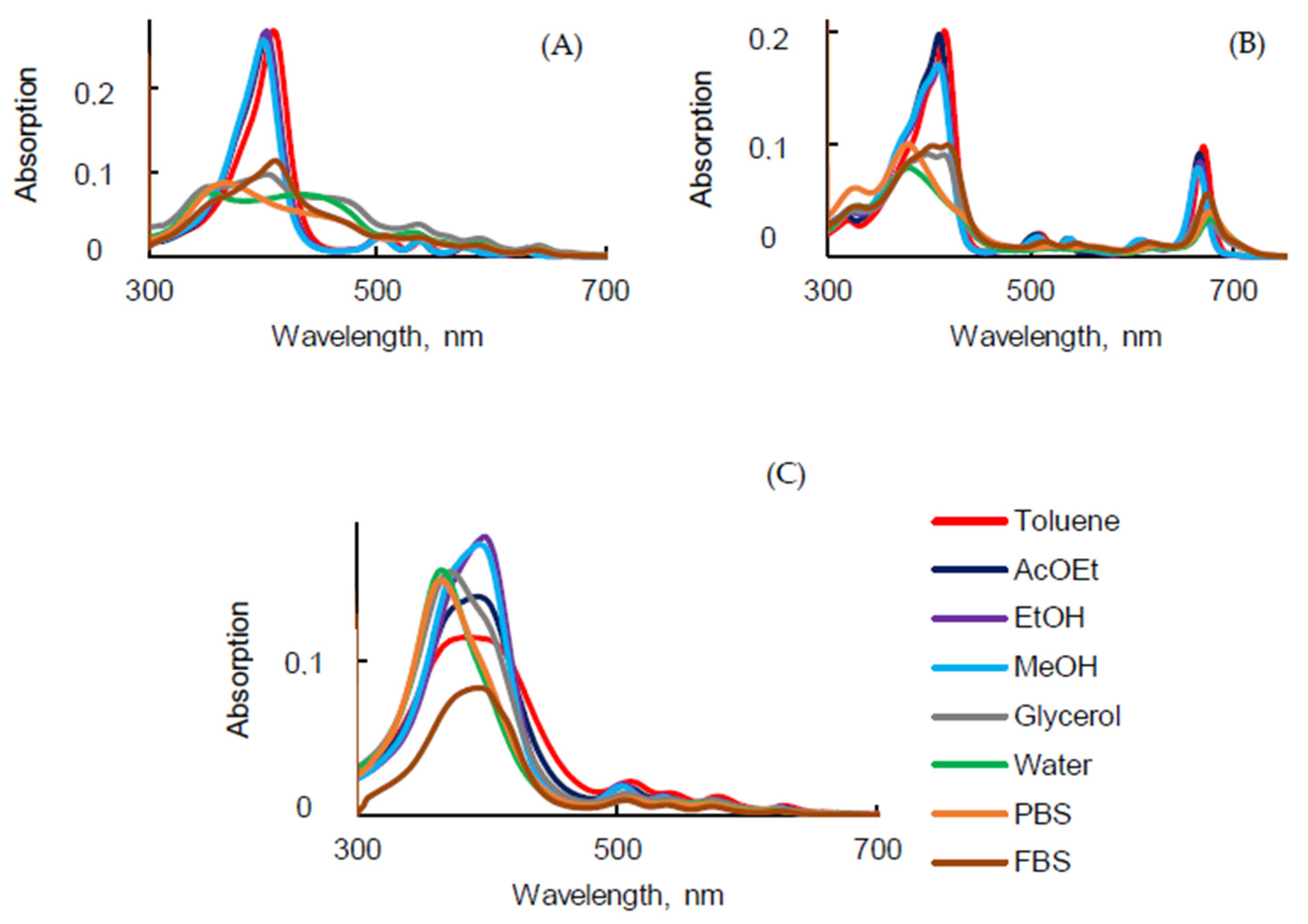
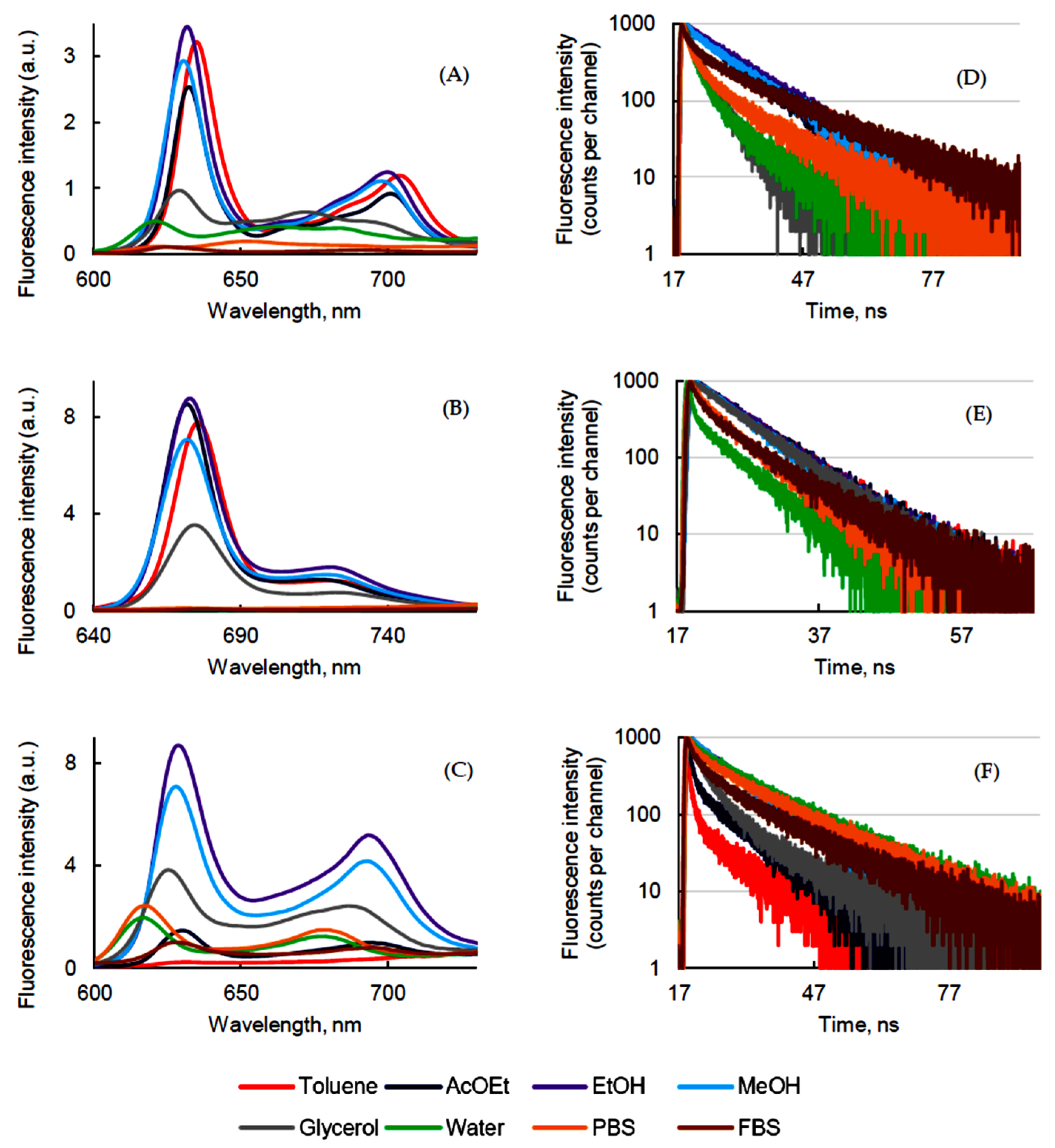
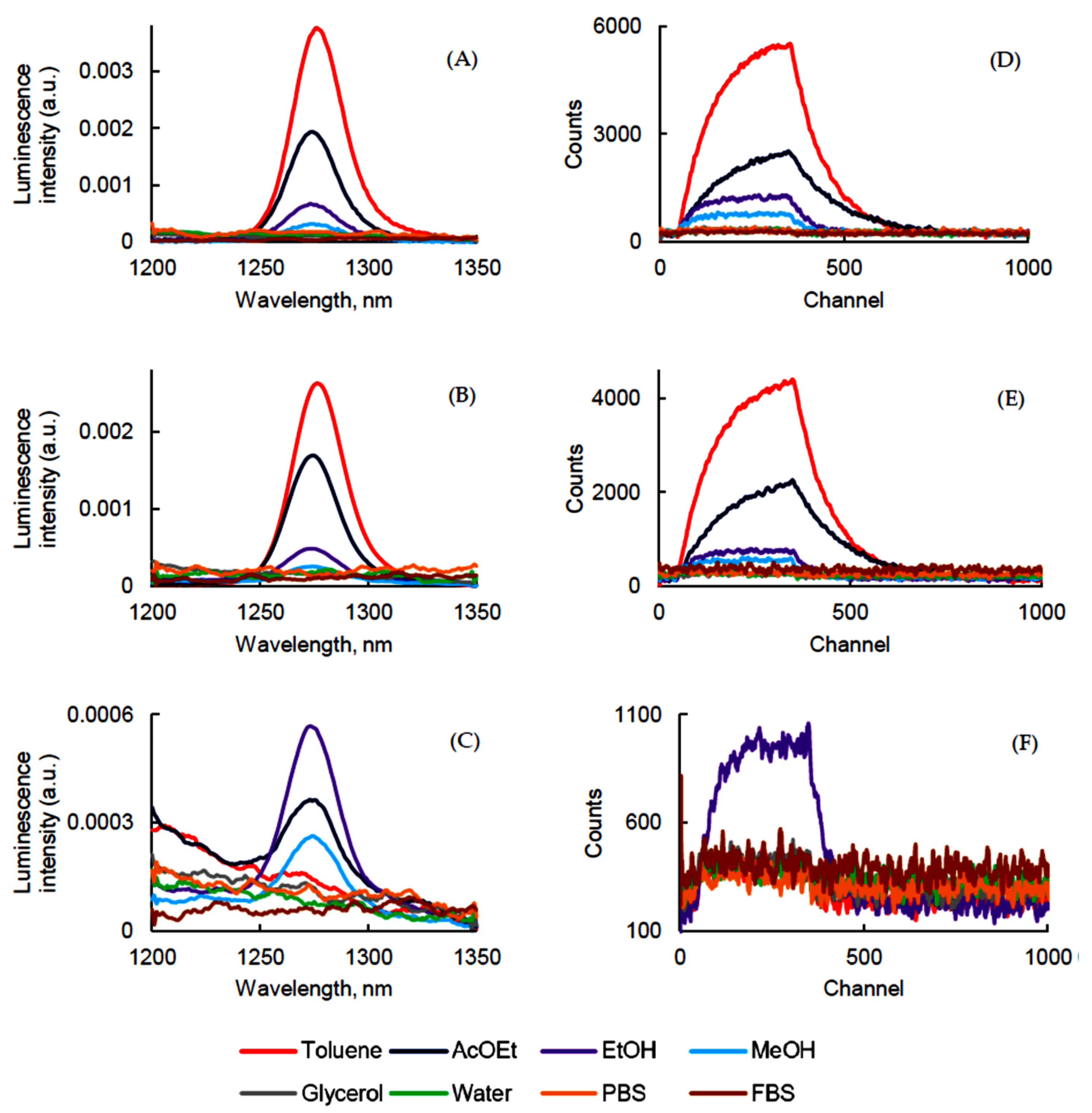

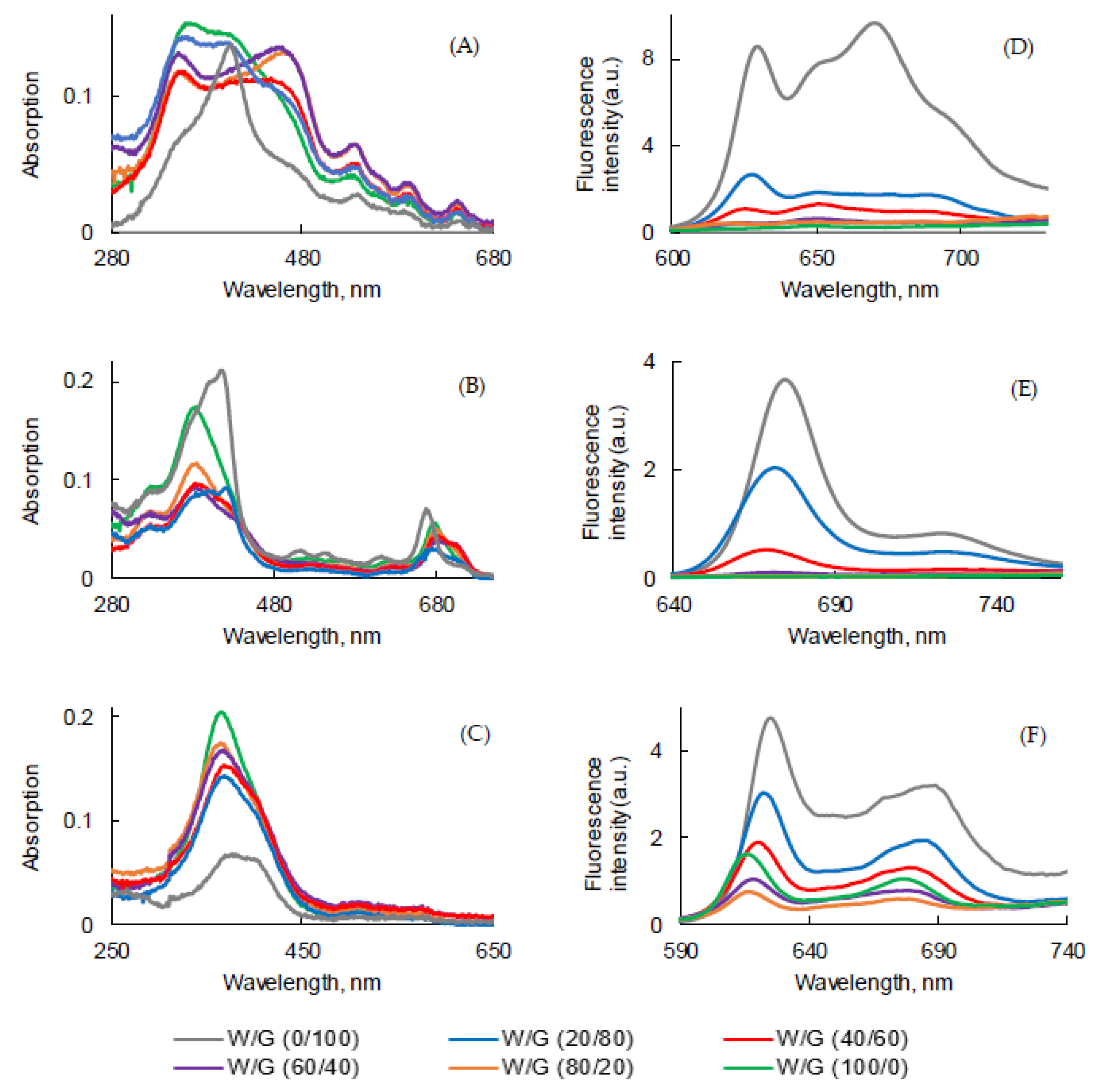
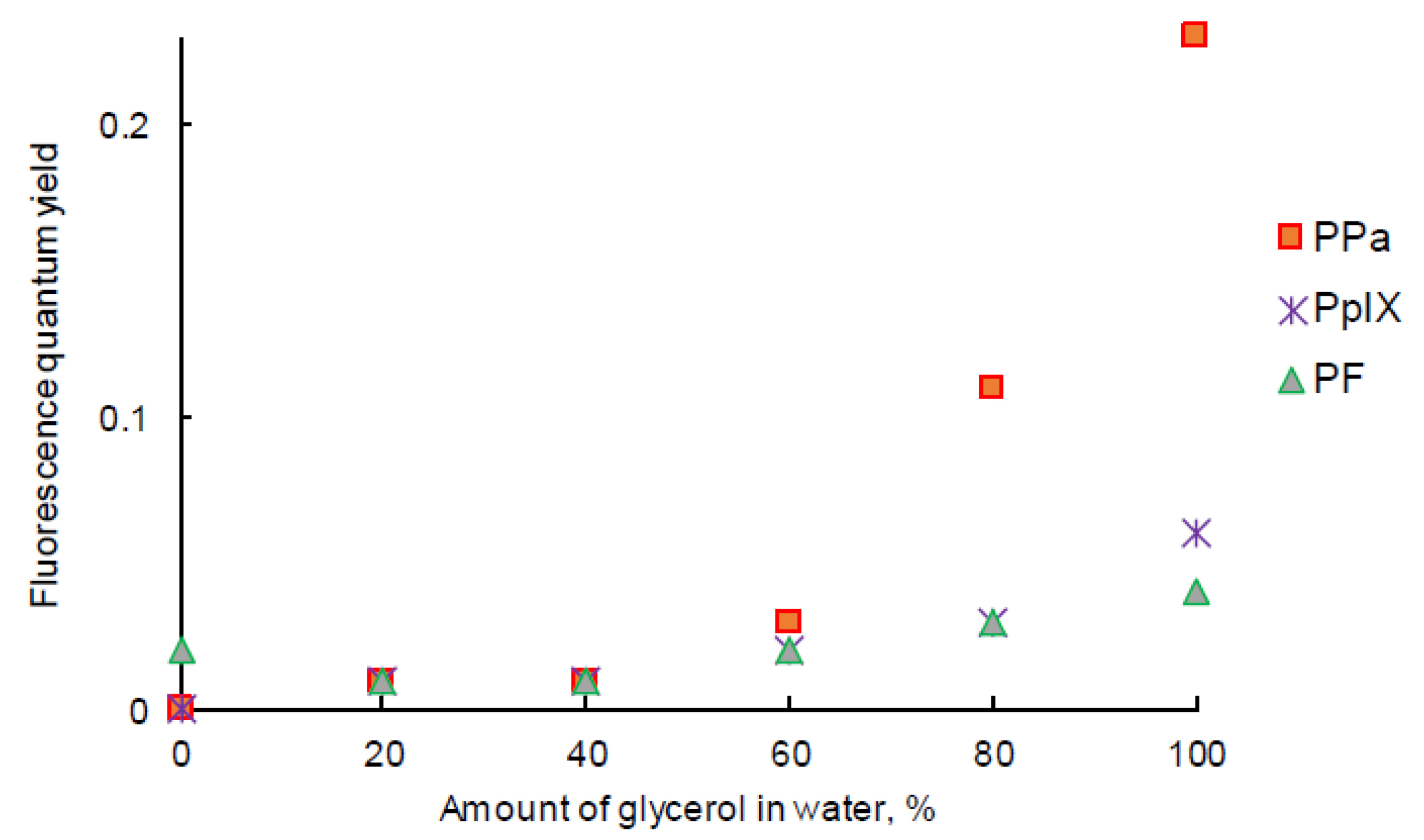
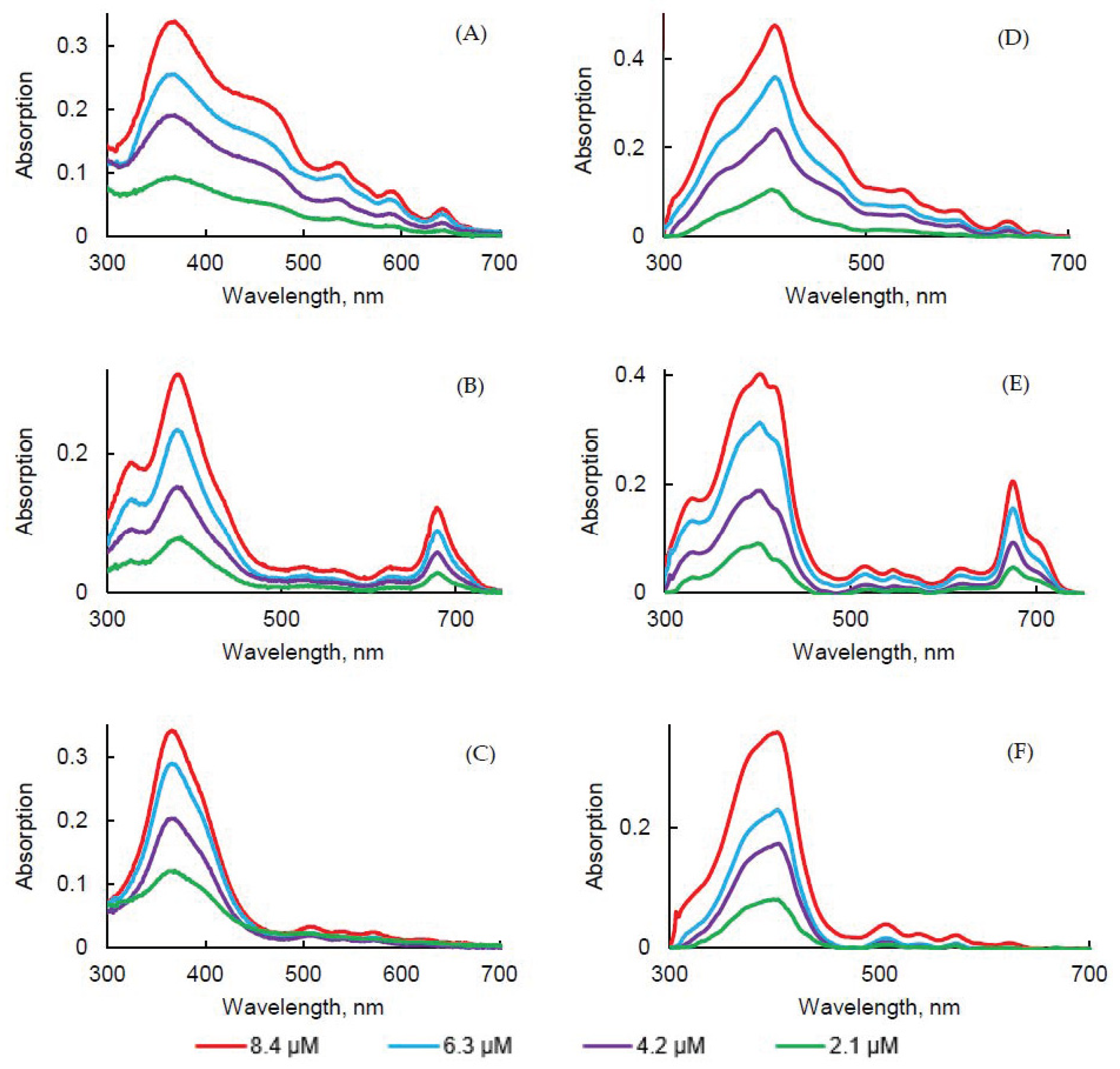
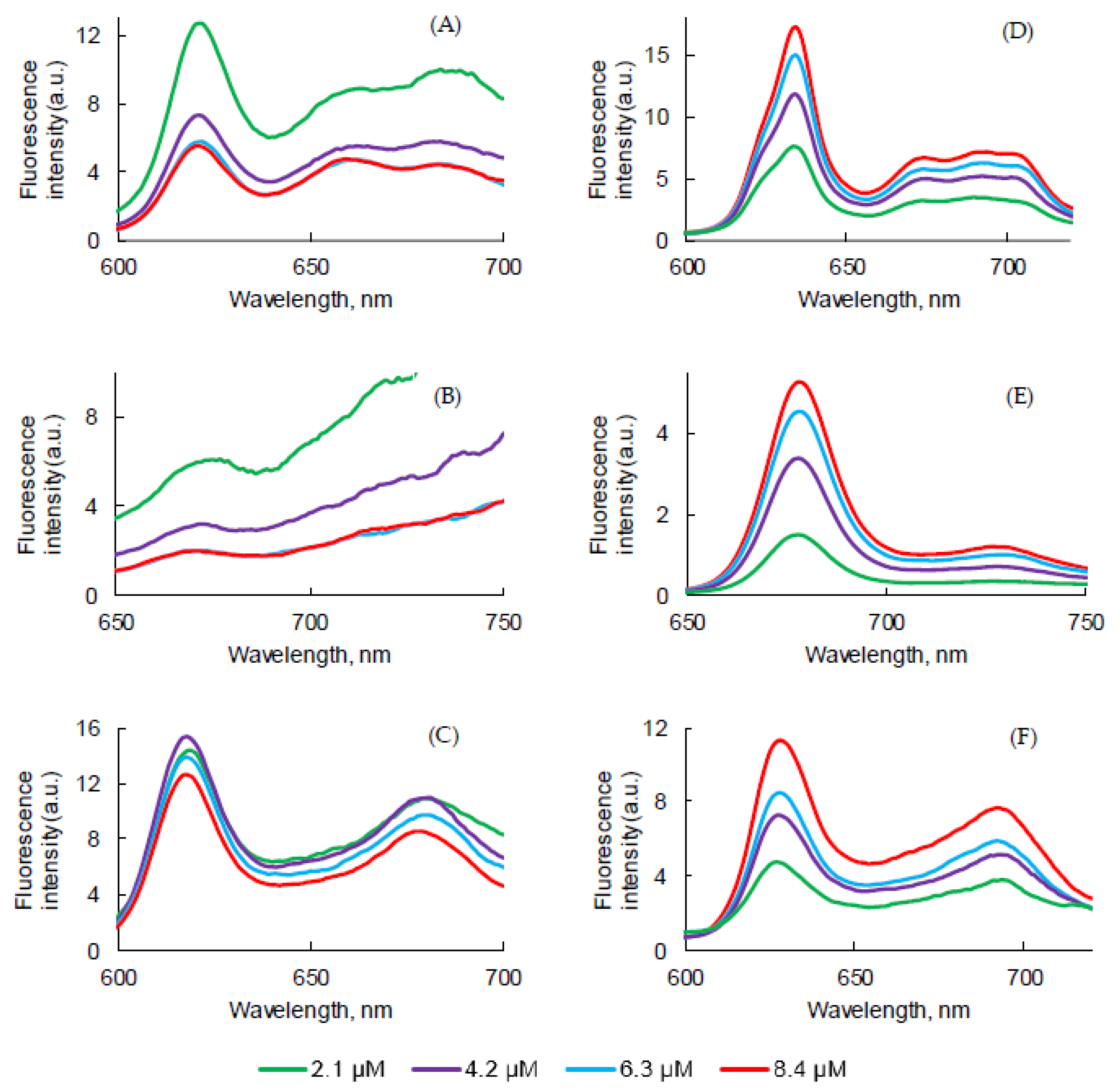
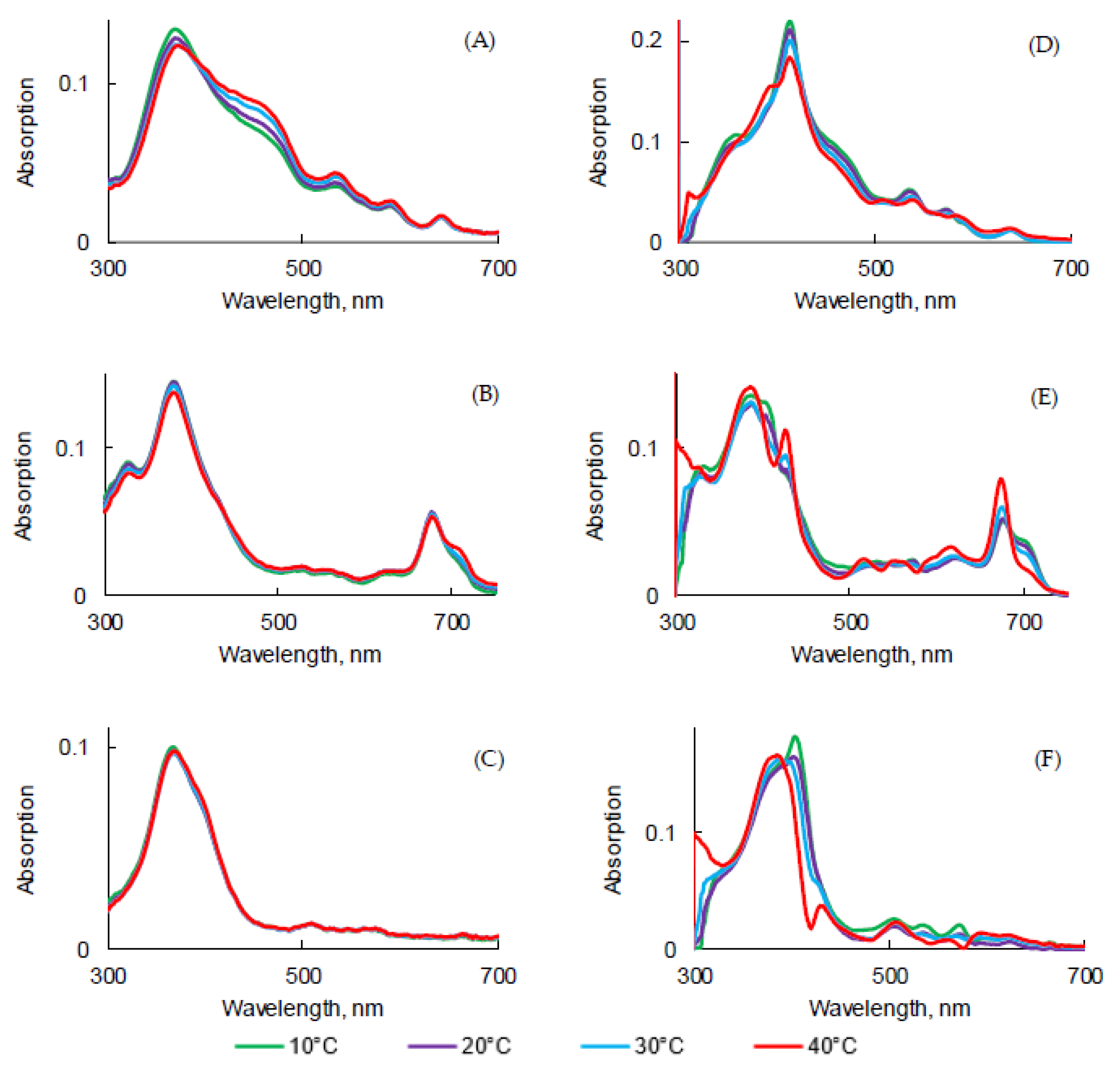
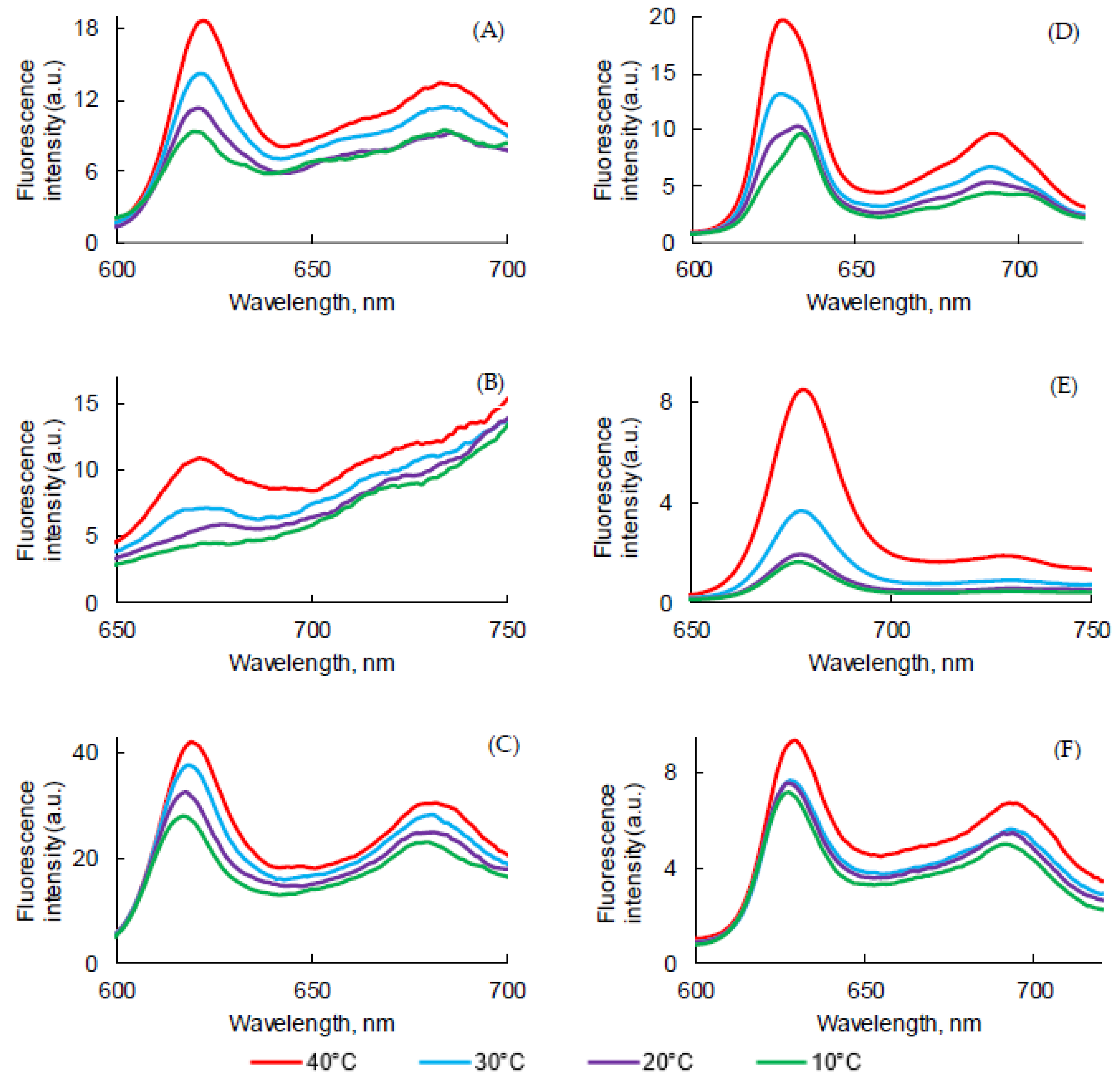
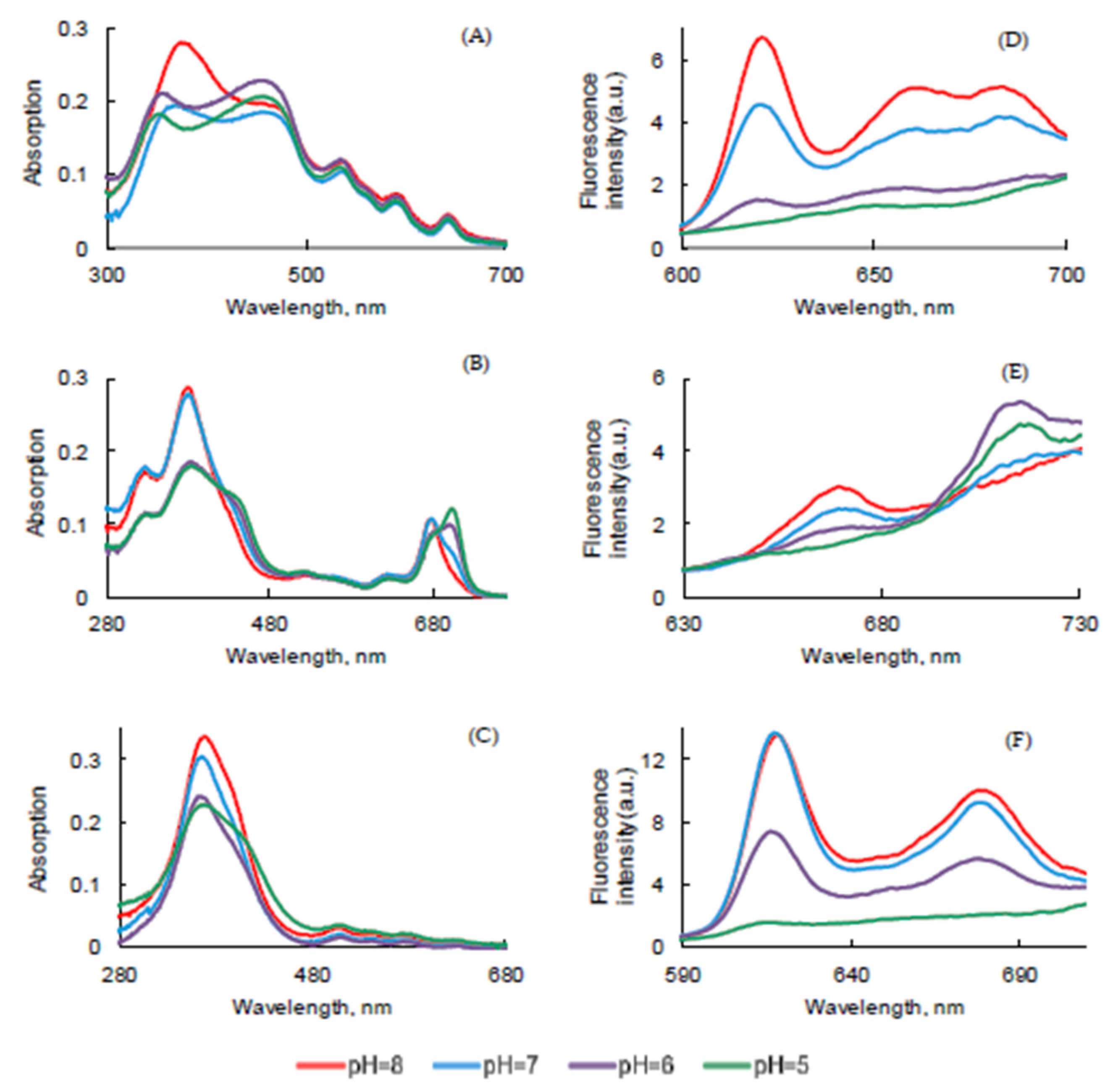
| Solvent | ET(30) | PpIX | PPa | PF | ||||||||||||
|---|---|---|---|---|---|---|---|---|---|---|---|---|---|---|---|---|
| Soret | QIV | QIII | QII | QI | Soret | QIV | QIII | QII | QI | Soret | QIV | QIII | QII | QI | ||
| Toluene | 33.9 | 409 | 506 | 540 | 577 | 632 | 415 | 510 | 539 | 612 | 671 | 388 | 509 | 539 | 578 | 628 |
| AcOEt | 38.1 | 402 | 503 | 536 | 575 | 630 | 410 | 506 | 536 | 608 | 667 | 394 | 503 | 536 | 574 | 625 |
| EtOH | 51.9 | 402 | 503 | 537 | 575 | 629 | 411 | 509 | 539 | 609 | 667 | 398 | 503 | 536 | 574 | 625 |
| MeOH | 55.4 | 401 | 502 | 537 | 574 | 628 | 409 | 507 | 538 | 608 | 665 | 394 | 503 | 536 | 574 | 625 |
| Glycerol | 57.0 | 404 | 536 | 561 | 590 | 642 | 415 | 512 | 544 | 616 | 671 | 371 | 507 | 536 | 574 | 625 |
| Water | 63.1 | 352 | 532 | 557 | 589 | 641 | 380 | 522 | 554 | 625 | 677 | 365 | 507 | 542 | 567 | 616 |
| PBS | ≈63.1 | 365 | 532 | 557 | 589 | 641 | 379 | 526 | 558 | 630 | 677 | 365 | 507 | 542 | 567 | 616 |
| FBS | - | 409 | 506 | 537 | 585 | 640 | 405 | 515 | 546 | 617 | 675 | 391 | 506 | 538 | 573 | 624 |
| Solvent | PpIX | PPa | PF | ||||||||||||
|---|---|---|---|---|---|---|---|---|---|---|---|---|---|---|---|
| Soret | QIV | QIII | QII | QI | Soret | QIV | QIII | QII | QI | Soret | QIV | QIII | QII | QI | |
| Toluene | 143,590 | 13,746 | 10,448 | 6481 | 5204 | 107,765 | 10,718 | 8589 | 7108 | 52,500 | 45,454 | 8535 | 5544 | 4705 | 2381 |
| AcOEt | 140,975 | 13,148 | 10,432 | 6113 | 5302 | 106,642 | 10,691 | 8455 | 6202 | 49,416 | 55,780 | 7351 | 4655 | 3854 | 2056 |
| EtOH | 142,440 | 13,305 | 10,615 | 6476 | 5067 | 92,874 | 9303 | 8403 | 7851 | 45,435 | 71,905 | 7832 | 4779 | 3661 | 1891 |
| MeOH | 139,797 | 12,410 | 10,048 | 6111 | 4579 | 94,334 | 9555 | 8771 | 8202 | 43,430 | 70,829 | 7333 | 4495 | 3497 | 1722 |
| Glycerol | 38,582 | 14,342 | 9180 | 8029 | 4909 | 46,057 | 5215 | 4989 | 4603 | 20,415 | 61,111 | 5151 | 3891 | 3531 | 1392 |
| Water | 40,603 | 15,326 | 9447 | 8177 | 5005 | 41,993 | 3900 | 3489 | 4179 | 17,311 | 61,617 | 3456 | 2806 | 2751 | 1044 |
| PBS | 47,433 | 11,565 | 7964 | 6945 | 4152 | 39,431 | 3699 | 3467 | 3937 | 15,444 | 59,023 | 3970 | 2786 | 2524 | 931 |
| FBS | 61,034 | 13,332 | 12,969 | 7436 | 4346 | 54,518 | 7172 | 6478 | 6808 | 31,092 | 45,952 | 5447 | 3515 | 2956 | 1387 |
| Solvent | ET(30) | Φf (± 0.01) | ||
|---|---|---|---|---|
| PpI | PPa | PF | ||
| Toluene | 33.9 | 0.09 | 0.39 | <0.01 |
| AcOEt | 38.1 | 0.06 | 0.34 | <0.01 |
| EtOH | 51.9 | 0.08 | 0.39 | 0.07 |
| MeOH | 55.4 | 0.07 | 0.31 | 0.05 |
| Glycerol | 57.0 | 0.04 | 0.20 | 0.02 |
| Water | 63.1 | <0.01 | <0.01 | 0.01 |
| PBS | ≈63.1 | <0.02 | <0.01 | 0.01 |
| FBS | - | <0.01 | <0.01 | <0.01 |
| Solvent | τf (ns) | |||
|---|---|---|---|---|
| PpIX | PPa | PF | References | |
| Toluene | 11.2 ± 0.06 | 6.7 ± 0.02 | 8.7 ± 0.2 | This work |
| AcOEt | 10.3 ± 0.1 | 6.6 ± 0.01 | 2.4 ± 0.2 (11%) 9.3 ± 0.2 (89%) | This work |
| EtOH | 11.6 ± 0.1 | 6.6 ± 0.01 | 10.8 ± 0.1 | This work |
| MeOH | 11.0 ± 0.02 | 6.1 ± 0.01 | 10.2 ± 0.1 | 10.0 ± 0.6 [38] [PF] |
| Glycerol | 2.9 ± 0.02 (66%) 6.4 ± 0.1 (34%) | 6.5 ± 0.01 | 3.0 ± 0.01 (64%) 12.0 ± 0.1 (36%) | This work |
| Water | 2.5 ± 0.05 (54%) 9.6 ± 0.4 (46%) | 0.3 ± 0.02 (1%) 5.5 ± 0.1 (99%) | 3.4 ± 0.08 (13%) 14.5 ± 0.08 (87%) | This work |
| PBS | 3.0 ± 0.2 (27%) 13.0 ± 0.3 (73%) | 1.4 ± 0.06 (15%) 5.7 ± 0.07 (85%) | 2.2 ± 0.08 (12%) 14.1 ± 0.1 (88%) | 13.2 ± 2.0 [38] [PF] 14.7 [39] [PF] |
| FBS | 2.9 ± 0.2 (10%) 15.9 ± 0.3 (90%) | 2.1 ± 0.2 (18%) 7.5 ± 0.1 (82%) | 3.2 ± 0.2 (21%) 15.0 ± 0.2 (79%) | This work |
| Solvent | ΦΔ (± 0.10) | ||
|---|---|---|---|
| PpIX | PPa | PF | |
| Toluene | 0.68 | 0.49 | 0.01 |
| EtOH | 0.92 | 0.53 | 0.80 |
| MeOH | 0.92 | 0.42 | 0.61 |
| D2O | - | - | 0.15 |
| Solvent | τΔ (μs) | Literature Values | ||
|---|---|---|---|---|
| PpIX | PPa | PF | ||
| Toluene | 30.4 ± 0.2 | 30.7 ± 0.2 | - | 30.5 ± 0.6 [42] [PS: 1H-phenalen-1-one-2- sulfonic acid (PNS)] |
| AcOEt | 44.1 ± 0.6 | 43.2 ± 0.5 | - | 45 ± 1.5 [42] [PS: 1H-phenalen-1-one-2- sulfonic acid (PNS)] |
| EtOH | 14.9 ± 0.6 | 14.6 ± 0.9 | 14.7 ± 0.8 | 15.3 ± 0.8, 12 [42,43] PS: hydrogen peroxide |
| MeOH | 12.6 ± 0.9 | 8.9 ± 1.3 | 9.1 ± 1.0 | 9.9 ± 0.3, 7 [42,43] PS: ozone-triphenylphosphite |
| (W/G, v/v) | τf (ns) | ||
|---|---|---|---|
| PpIX | PPa | PF | |
| W/G (100/0) | 2.7 ± 0.02; 8.0 ± 0.1 | 0.3 ± 0.01; 5.5 ± 0.1 | 3.3 ± 0.1; 13.8 ± 0.2 |
| W/G (80/20) | 2.4 ± 0.04; 9.2 ± 0.3 | 0.1 ± 0.01; 5.6 ± 0.03 | 3.7 ± 0.02; 12.8 ± 0.04 |
| W/G (60/40) | 3.0 ± 0.01; 10.3 ± 0.1 | 0.1 ± 0.01; 5.7 ± 0.03 | 4.2 ± 0.02; 12.6 ± 0.04 |
| W/G (40/60) | 3.1 ± 0.02; 10.9 ± 0.2 | 5.5 ± 0.03 | 3.8 ± 0.04; 12.3 ± 0.1 |
| W/G (20/80) | 3.1 ± 0.05; 12.3 ± 0.4 | 5.9 ± 0.02 | 3.6 ± 0.02; 14.4 ± 0.05 |
| W/G (0/100) | 3.2 ± 0.02; 12.5 ± 0.2 | 6.5 ± 0.02 | 3.5 ± 0.01; 15.2 ± 0.05 |
| Concentration (μM) | τf (ns) | ||
|---|---|---|---|
| PpIX | PPa | PF | |
| PBS | |||
| 2.1 | 3.8 ± 0.2 (21%) 14.5 ± 0.2 (79%) | 6.8 ± 0.1 | 2.1 ± 0.3 (8%) 14.0 ± 0.2 (92%) |
| 4.2 | 3.6 ± 0.2 (22%) 13.8 ± 0.2 (78%) | 5.9 ± 0.1 | 2.7 ± 0.4 (8%) 14.8 ± 0.2 (92%) |
| 6.3 | 3.5 ± 0.2 (25%) 12.8 ± 0.2 (75%) | 5.8 ± 0.1 | 2.4 ± 0.3 (8%) 14.7 ± 0.2 (92%) |
| 8.4 | 3.8 ± 0.2 (27%) 13.7 ± 0.2 (73%) | 5.6 ± 0.1 | 2.6 ± 0.4 (8%) 14.8 ± 0.2 (92%) |
| FBS | |||
| 2.1 | 3.7 ± 0.2 (13%) 17.0 ± 0.1 (87%) | 3.5 ± 0.3 (13%) 8.2 ± 0.1 (87%) | 3.3 ± 0.3 (17%) 15.3 ± 0.2 (83%) |
| 4.2 | 3.6 ± 0.3 (12%) 17.1 ± 0.2 (88%) | 2.5 ± 0.6 (5%) 8.2 ± 0.1 (95%) | 3.6 ± 0.3 (15%) 15.5 ± 0.2 (85%) |
| 6.3 | 3.9 ± 0.4 (11%) 17.8 ± 0.2 (89%) | 2.6 ± 0.5 (5%) 8.2 ± 0.1 (95%) | 3.4 ± 0.3 (14%) 15.6 ± 0.2 (86%) |
| 8.4 | 3.9 ± 0.4 (11%) 17.8 ± 0.2 (89%) | 3.2 ± 0.2 (4%) 8.5 ± 0.2 (96%) | 3.4 ± 0.3 (14%) 15.7 ± 0.2 (86%) |
| Temperature, °C | Fluorescence Lifetime (ns) | ||
|---|---|---|---|
| PpIX | PPa | PF | |
| PBS | |||
| 10 | 5.7 ± 0.4 (19%) 16.4 ± 0.3 (81%) | 5.8 ± 0.1 | 2.4 ± 0.3 (9%) 14.6 ± 0.2 (91%) |
| 20 | 4.6 ± 0.3 (16%) 15.4 ± 0.2 (84%) | 5.6 ± 0.1 | 2.9 ± 0.3 (9%) 14.8 ± 0.2 (91%) |
| 30 | 4.6 ± 0.4 (13%) 13.9 ± 0.2 (87%) | 5.5 ± 0.1 | 2.6 ± 0.2 (9%) 14.6 ± 0.2 (91%) |
| 40 | 4.0 ± 0.4 (13%) 14.1 ± 0.2 (87%) | 5.3 ± 0.1 | 2.6 ± 0.3 (9%) 14.6 ± 0.2 (91%) |
| FBS | |||
| 10 | 3.9 ± 0.5 (9%) 18.0 ± 0.2 (91%) | 2.8 ± 0.3 (10%) 7.8 ± 0.1 (90%) | 3.0 ± 0.2 (16%) 15.0 ± 0.2 (84%) |
| 20 | 3.4 ± 0.4 (8%) 18.0 ± 0.2 (92%) | 2.0 ± 0.3 (7%) 7.7 ± 0.1 (93%) | 2.8 ± 0.2 (16%) 14.7 ± 0.2 (84%) |
| 30 | 3.3 ± 0.4 (7%) 17.9 ± 0.2 (93%) | 7.3 ± 0.1 | 2.8 ± 0.2 (16%) 14.7 ± 0.2 (84%) |
| 40 | 3.2 ± 0.4 (6%) 17.6 ± 0.2 (94%) | 7.2 ± 0.1 | 2.6 ± 0.2 (16%) 13.8 ± 0.2 (84%) |
| pH | τf (ns) | ||
|---|---|---|---|
| PpIX | PPa | PF | |
| 5 | 5.0 ± 0.2 | 3.5 ± 0.4 | 2.2 ± 0.2 (21%) 11.2 ± 0.2 (79%) |
| 6 | 5.7 ± 0.4 (42%) 13.1 ± 0.5 (58%) | 5.1 ± 0.3 | 3.6 ± 0.5 (9%) 14.8 ± 0.2 (91%) |
| 7 | 4.3 ± 0.06 (30%) 14.6 ± 0.1 (70%) | 5.5 ± 0.1 | 2.7 ± 0.3 (9%) 15.0 ± 0.2 (91%) |
| 8 | 3.7 ± 0.2 (23%) 14.6 ± 0.2 (77%) | 5.6 ± 0.09 | 2.4 ± 0.2 (8%) 14.4 ± 0.2 (92%) |
Publisher’s Note: MDPI stays neutral with regard to jurisdictional claims in published maps and institutional affiliations. |
© 2021 by the authors. Licensee MDPI, Basel, Switzerland. This article is an open access article distributed under the terms and conditions of the Creative Commons Attribution (CC BY) license (http://creativecommons.org/licenses/by/4.0/).
Share and Cite
Myrzakhmetov, B.; Arnoux, P.; Mordon, S.; Acherar, S.; Tsoy, I.; Frochot, C. Photophysical Properties of Protoporphyrin IX, Pyropheophorbide-a, and Photofrin® in Different Conditions. Pharmaceuticals 2021, 14, 138. https://doi.org/10.3390/ph14020138
Myrzakhmetov B, Arnoux P, Mordon S, Acherar S, Tsoy I, Frochot C. Photophysical Properties of Protoporphyrin IX, Pyropheophorbide-a, and Photofrin® in Different Conditions. Pharmaceuticals. 2021; 14(2):138. https://doi.org/10.3390/ph14020138
Chicago/Turabian StyleMyrzakhmetov, Bauyrzhan, Philippe Arnoux, Serge Mordon, Samir Acherar, Irina Tsoy, and Céline Frochot. 2021. "Photophysical Properties of Protoporphyrin IX, Pyropheophorbide-a, and Photofrin® in Different Conditions" Pharmaceuticals 14, no. 2: 138. https://doi.org/10.3390/ph14020138
APA StyleMyrzakhmetov, B., Arnoux, P., Mordon, S., Acherar, S., Tsoy, I., & Frochot, C. (2021). Photophysical Properties of Protoporphyrin IX, Pyropheophorbide-a, and Photofrin® in Different Conditions. Pharmaceuticals, 14(2), 138. https://doi.org/10.3390/ph14020138









